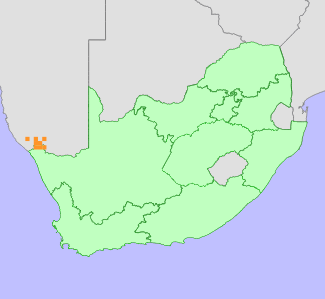|
Scientific Name | Conophytum quaesitum (N.E.Br.) N.E.Br. subsp. quaesitum |
Higher Classification | Dicotyledons |
Family | AIZOACEAE |
National Status |
Status and Criteria | Vulnerable A3d |
Assessment Date | 2021/12/02 |
Assessor(s) | A.J. Young, P.G. Desmet, I. Ebrahim, D. Guo, A. Harrower, L. Jabar, L. Knoetze, C. Rodgerson, P.C.V. Van Wyk & N.N. Mhlongo |
Justification | This succulent is endemic to the Karas region of Namibia and the Northern Cape province of South Africa with an extent of occurrence (EOO) of 6,128 km2 and area of occupancy (AOO) of 112 km2. The dwarf succulents that comprise this genus have been increasingly targeted by illegal collection in recent years and the vast majority of species are in high demand by collectors. Whilst there is no evidence of illegal collection at the time of this submission, closely related species, including some from the immediate area, have been illegally removed from habitat with a dramatic increase in the number of species and volume of plants targeted since 2019. The threat of illegal collection is therefore regarded as high for this particular taxon. However its scattered distribution across a remote and sometimes inaccessible landscape may limit any decline due to collection. A decline of 30-45% of the population is thus suspected over the next three generations (90 years). Climate change is also impacting the population although there is uncertainty of the response given the expected resilience of this taxon. It therefore qualifies as Vulnerable under criterion A3. |
Distribution |
Endemism | Not endemic to South Africa |
Provincial distribution | Northern Cape |
Range | This succulent is restricted to remote mountains in the Richtersveld of the Northern Cape province of South Africa and the Karas region of Namibia. |
Habitat and Ecology |
Major system | Terrestrial |
Major habitats | Desert, Succulent Karoo |
Description | This succulent is restricted to the Richtersveld and Gariep Desert bioregions of the Succulent Karoo and Desert biomes, respectively. Plants are found in shade or partial shade on steep slopes with quartz and gneiss and ironstone formations where it often grows on steep faces and deep, narrow, crevices.
This taxon has a generation length of 30 years. It is expected to be sensitive to the impacts of climate change as it does not disperse and while adapted to arid conditions, is dependent on limited seasonal rainfall. Species in the genus are sensitive to long periods of drought. Drought related mortality has been observed for other closely related taxa within the genus. |
Threats |
| This particular taxon is not currently threatened by illegal collection but it is likely that it will become a target in coming years as there has been a dramatic increase in the number of species and volume of plants of this genus targeted since 2019. Related species within much of its geographic range have experienced severe declines in population number due to illegal collection. The majority of subpopulations are in remote and often inaccessible locations which may limit losses due to collection 30-45% over three generations (90 years).
Anthropogenic climate change is a long-term threat to this succulent. Loss of vegetation cover has been observed across the geographic range occupied by this taxon via Landsat imagery between 1984 and 2018 indicating a decline in habitat quality. Climate models for the likely emission scenarios where emissions stay at present day levels (RCP 2.6) (Hausfather and Peters 2020) and worst case scenarios where emissions continue to increase during the 21st century (RCP 8.5) indicate that there will be a loss of suitable bioclimatic envelope of between 46% and 70% by 2080 for this taxon. However, as this taxon occurs in a very sheltered habitat it is expected to have a level of resilience to climate change and the expected population loss is reduced by 20% to 26%. Species in this genus have limited dispersal ability and migration to suitable habitats elsewhere is regarded as highly unlikely.
Mining and associated infrastructure represents a threat to some localised populations. |
Population |
It is difficult to properly assess the population size of this succulent due to its widespread and scattered distribution across a remote and sometimes inaccessible area but there are likely to be between 50,000 and 100,000 mature individuals. This taxon can be locally abundant, however in response to an extended drought in the Richtersveld that started in 2016 and is still ongoing at the time of assessment, the population is suspected to be declining.
|
Population trend | Unknown |
Assessment History |
Taxon assessed |
Status and Criteria |
Citation/Red List version | | Conophytum quaesitum (N.E.Br.) N.E.Br. subsp. quaesitum var. quaesitum | Least Concern | Raimondo et al. (2009) | | Conophytum quaesitum (N.E.Br.) N.E.Br. subsp. quaesitum var. rostratum (Tischer) S.A.Hammer | Least Concern | Raimondo et al. (2009) | |
Bibliography |
Hammer, S. 2002. Dumpling and his wife: New view of the genus Conophytum. EAE Creative Colour, Norwich.
Hammer, S.A. 1993. The genus Conophytum: A conograph. Succulent Plant Publications, Pretoria.
Hausfather, Z. and Peters, G.P. 2020. Emissions - the 'business as usual' story is misleading. Nature 577(618-620).
|
Citation |
| Young, A.J., Desmet, P.G., Ebrahim, I., Guo, D., Harrower, A., Jabar, L., Knoetze, L., Rodgerson, C., Van Wyk, P.C.V. & Mhlongo, N.N. 2021. Conophytum quaesitum (N.E.Br.) N.E.Br. subsp. quaesitum. National Assessment: Red List of South African Plants version 2024.1. Accessed on 2025/10/25 |
 Comment on this assessment
Comment on this assessment


